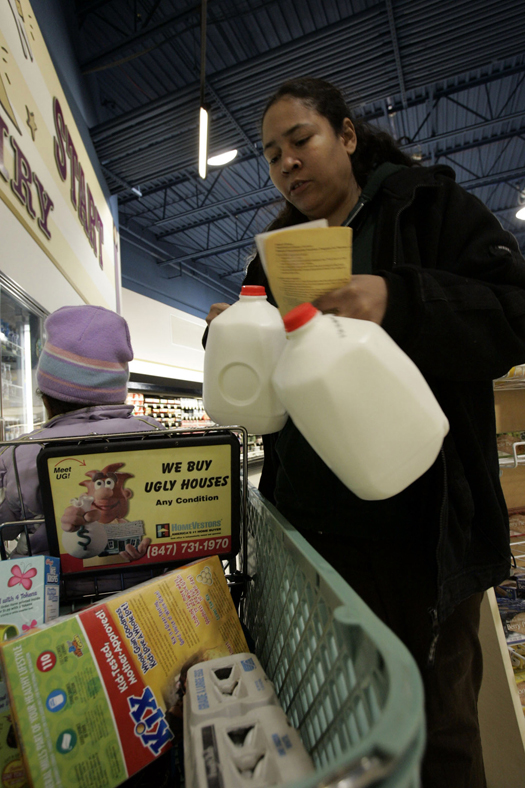
Markita Barrett, 35, using her WIC vouchers, places two gallon jugs of milk into her cart as she shops for juice and other foods at the Piggley Wiggley in Zion, Illinois, April 4, 2008. Barrett and her roommate feed themselves and two girls, age 10 and 22 months, on a $540 allotment from food stamps. (David Trotman-Wilkins/Chicago Tribune/MCT)
WASHINGTON – One in five Americans said they lacked enough money at times in the past year to buy the food they or their families needed, a new Gallup poll shows.
Little wonder, then, that critics say a Republican bill to slash food stamp spending by $40 billion over the next 10 years would prove devastating to families struggling to put food on the table.
“It’s awful; I don’t have enough words to express what a terrible, unprecedented slashing of the safety net this is,” Deborah Weinstein, executive director of the Coalition on Human Needs, told Youth Today.
“This is a cut that would affect 4 million to 6 million people. A great many of them would be in households with children.”
Indeed, the Center on Budget and Policy Priorities says nearly 72 percent of SNAP recipients are in families with children.
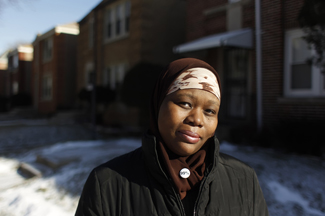 |
| Shani Smith, shown outside her home on the South Side of Chicago, Illinois, on January 18, 2012, currently receives food stamps to help ends meet. (Chris Walker/Chicago Tribune/MCT) |
CBPP and CHN, a Washington-based coalition of organizations focused on needs of low-income and vulnerable people, have joined other advocacy groups and Democratic lawmakers in decrying the GOP legislation.
A vote is expected this week on the bill to cut the food stamp program, formally known as the Supplemental Nutrition Assistance Program (SNAP).
In a Sept. 6 memo from House Majority Leader Eric Cantor, R-VA, to House Republicans, Cantor asserted SNAP, which now serves about 48 million people, or roughly one in seven Americans, has become a “safety net [that has] gone well beyond assistance to children, seniors, and the disabled.”
The cost of the SNAP program, now about $80 billion a year, has more than doubled since 2007.
Precisely why is open to considerable debate.
Some Republicans say the program has ballooned because it is rife with fraud and abuse and people who don’t really need food stamps receive them, including some who are able to work but do not seek employment.
Critics of the proposed cuts, however, counter that the overwhelming majority of those able to work who receive food stamps either work at jobs that don’t pay them enough to afford adequate food or can’t find jobs because of high unemployment, particularly among low-income people.
“The reason that you have a higher number of people who are eligible for SNAP is because since 2008, you’ve had a higher number of people who are out of work and who are struggling or who may be working but at a much lower salary than they were before,” Michael Mershon, press secretary for Rep. Jim McGovern, D-MA, told Youth Today.
“So the way to decrease SNAP enrollment is not to cut the benefit for people who need it,” he said. “It’s to put people back to work and to create jobs that actually pay a decent wage.”
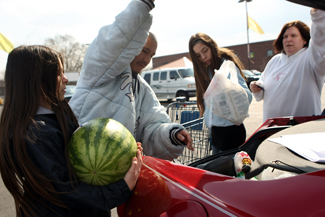 |
| Mary Hawkins (far right) and her husband, Armando Zavala, (second left) of Park City, Illinois, and their daughters Abigail, 13, and Natalie, 11, (far left) load groceries into their car after their monthly food shopping trip to Lewis Produce Market in Waukegan, Illinois, Friday, April 4, 2008. The family receives a monthly food stamp allotment of $310 dollars. (Scott Strazzante/Chicago Tribune/MCT) |
As for the fraud and abuse claims, the Washington-based Center on Budget and Policy Priorities, which examines the effects of budget and tax policies on low-income Americans, says SNAP has consistently received bipartisan congressional review as well as strong scrutiny from the U.S. Department of Agriculture.
The CBPP noted the SNAP overpayment rate – the proportion of benefits either issued to ineligible households or overpaid to eligible households – totaled only 2.77 percent last year, with the overwhelming majority of overpayments resulting not from fraud but mistakes by recipients, eligibility workers, data-entry clerks or computer programmers.
In his memo, Cantor also said the proposed cuts wouldn’t endanger benefits to anybody who needs them: “Most importantly, no individual who meets the income and asset guidelines of the SNAP program and is willing to comply with applicable work requirements will lose benefits as a result of these reforms.”
But CBPP notes four of five current SNAP households live below the poverty line — $23,550 for a family of four in 2013.
And some 49 million people last year lacked consistent access to adequate food necessary to ensure “active healthy living for all household members” throughout the year, the Department of Agriculture reports. The USDA defines such households as “food insecure,” and the proportion of these households in the U.S. has remained virtually unchanged since 2008, despite the dramatic increase in the number of people receiving food stamps.
Widespread unemployment and the growing number of low-paying jobs also have hit children hard: One in two American children spend at least a few months during childhood on food stamps, according to the Washington-based anti-hunger group the Food Research and Action Center (FRAC).
Receiving food stamps also automatically makes a child eligible for free school meals, and FRAC says the GOP plan would cut some 210,000 children from the free school meal rolls.
The Senate has already approved a measure that would reduce SNAP spending by $4 billion over 10 years, while the House defeated an earlier bill that would have cut it by $20 billion over a decade.
The House measure had been opposed by Democrats, who thought the proposed SNAP cut was much too large, as well as some conservative Republicans, who want deeper cuts to the nutrition program.
Speaking of the proposed SNAP spending cutback, FRAC Legal Director Ellen Vollinger said: “It’s appalling. We don’t think that it’s recognition of reality… at a time when a national survey shows one in five Americans struggle to afford food.”
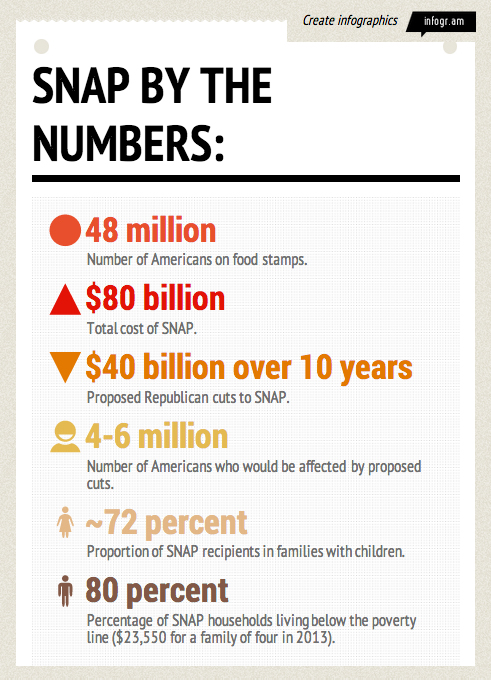
Vollinger said many people who receive food stamps never thought they would need them.
“Sometimes, people think that SNAP is just a program for other people, but it’s not uncommon for Americans to go through fits and starts of problems,” Vollinger said.
“I mean there are some people who have chronic situations, but there are a lot of people who need a bridge. They need temporary help. Something’s happened and particularly in this recession, there are probably a lot of workers who never thought that they would need the program, but they’ve either lost jobs and had a hard time getting a job back or their hours were cut back or were not sufficient.”
As for the claim that the number of SNAP recipients has spiraled out of control, the Congressional Budget Office has said the total likely will plateau in 2014, then level off. A decline in SNAP participation historically has lagged behind economic recovery, and the beginning of this recovery is no exception.
Provisions Republicans are seeking also would tighten requirements that recipients work or receive job training. But in some cases, that’s asking the impossible, advocates say.
“You know the claims around ‘we just want people who can work to get work’ kind of sound hollow, I think, because in many cases, there’s just not jobs available,” Ed Bolen, a senior policy analyst at CBPP, told Youth Today.
“These provisions aren’t testing people’s willingness to work. They’re just saying, ‘You can’t get SNAP unless you jump through this hurdle of finding a job or finding a job-training program, and if there’s none in your community, you’re out of luck no matter how badly you’d like to work.’”
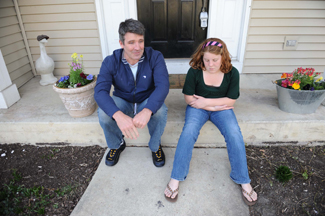 |
| Patrick Robbins, 41, left, and daughter Grace, 11, sit outside their Westmont, Illinois home, April 17, 2009. Robbins was an executive for 23 years with a retail clothing company and was laid off when the company went bankrupt. The family had to put their house on the market and apply for food stamps. (Candice C. Cusic/Chicago Tribune/MCT) |
Bolen noted all food stamp recipients already face a cut in benefits because a temporary boost to SNAP that came with the federal stimulus in 2009 will end Nov. 1. For a family of four, that means nearly $400 less a year.
“They’re already facing that cut,” Bolen said. “They’re already going to be under hardship, and for some of them it will be significant. They may have to turn to food pantries or food banks for assistance.”
Historically, Bolen notes, there’s been widespread support for food stamps on both sides of the congressional aisle.
“There’s always been bipartisan support for SNAP, and this is one of the harsher proposals to come down the pike in years,” he said.
But Mershon, Representative McGovern’s press secretary, said he’s not surprised by the proposal.
“I wish I could say we were surprised, but after several years of dealing with a Republican party that’s increasingly beholden to the Tea Party, I’m not surprised,” Mershon said. “It’s very disappointing, but you know they have shown no compunction. They have shown a willingness to go after poor people again and again and again, and this is just one more example of that.
“It’s on top of cuts to Head Start, it’s on top of cuts to job-training programs, it’s on top of states cutting back on their education budgets. All of these things are contributing to the worsening of poverty, especially among children in America, and it’s absolutely horrendous.”


























